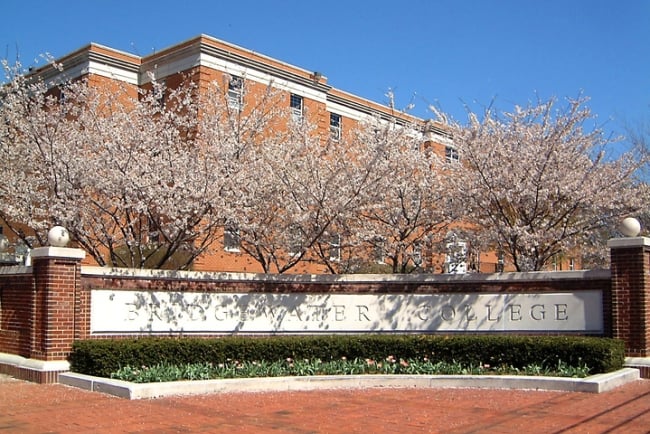You have /5 articles left.
Sign up for a free account or log in.

Bridgewater College in Virginia recently announced it will drop the sticker price for tuition by more than 60 percent starting next year.
Wikimedia Commons
Two small, private colleges, Bridgewater College in Virginia and Wartburg College in Iowa, recently announced drastic reductions in tuition prices—by 62 percent and 48 percent, respectively—starting next fall. The majority of their students won’t see much of a change in their actual bills, however.
That’s because relatively few students at the two institutions, as is true at many colleges and universities, were paying the advertised sticker price. Many were already benefiting from generous scholarships and financial aid packages that made their net tuition costs far less. While some critics have characterized tuition resets as pricing gimmicks, they’ve become more common in the last decade, and especially since the pandemic.
And as an expected enrollment cliff looms large, more colleges may look to this increased cost transparency as a strategy for attracting more students. While it’s far from clear that tuition resets can guarantee an enrollment bump, they do offer one potential way to address the increasing public skepticism about the value of higher education.
A recent survey from New America, a left-leaning think tank, found that only 53 percent of Americans think accessing high-quality higher education is affordable.
David Bushman, president of Bridgewater, said the decision to cut the tuition price was to make that value proposition clear.
"Our whole strategy was to make us more accessible by not being off-putting and dissuading families from looking more closely,” he said. “The whole motivation here is about being transparent. The old model is complicated and confusing because you have to wait to see what scholarship you get. This is much more straightforward.”
Bushman believes public perceptions—“that high price means high value”—that once drove college selection decisions have shifted and are now “probably broken.” He says, “An outright economic decision is now the primary consideration” driving college decisions.
Both Bridgewater’s and Wartburg’s tuition resets are considered unusually high. Bridgewater’s tuition will drop from $40,300 a year to $15,000 and Wartburg’s will decrease from $48,490 to $25,000. But not many students are paying full price even now, which is a common experience at colleges across the country.
“I don’t think you can be a small, private college and not have at least thought about resets,” said Bushman, who added that as far as he’s aware, virtually no student enrolled at Bridgewater is currently paying the full $40,000 tuition. “We were in a position doing what everyone’s been doing—the high-tuition/high-discount model—for a very long time, and I suppose for a time that worked well. But I do think the economic fragility created by the Great Recession and then the COVID recession has made families a lot more price conscious.”
According to a 2023 report produced by Sallie Mae, a private student loan lender, and Ipsos, a market research and consulting firm, 78 percent of families said they eliminated colleges from consideration based on price.
Bushman said Bridgewater’s reset will put the sticker price much closer to those of public colleges in the state with which Bridgewater competes for students. (James Madison University’s published tuition and fees for in-state students are $13,576, and George Mason University charges $13,815.) He said the reset plan has been in the works for a couple of years. Part of that was in response to Bridgewater’s declining enrollment, which fell from 1,875 in 2016 to an estimated 1,425 this year.
“It is getting more competitive. There are fewer students, but for the populations that are now going to be looking at college, I want to make sure we’re communicating our accessibility to them,” Bushman said.
Other than highly selective, name-brand institutions, he said, “Everybody is going to get to a place where they have to reckon with this reality.”
Bushman said he fully expects the reset to be “enrollment-positive.”
Enrollment
Research shows, however, that the connection between slashing sticker prices and increased enrollment is highly variable.
“There’s not a ton of evidence that enrollment will increase after a tuition reset,” said James Ward, a senior researcher at Ithaka S+R who has studied tuition resets. “But there’s an important caveat to that: we do see some evidence that as the resets are larger, we do start detecting effects” of increased enrollment.
Rebecca Ehretsman, Wartburg’s president, said in an email that the college already got a taste of how publicizing a tuition reduction can grow enrollment. After it enacted a marketing campaign devoted to making clear to every prospective student that if admitted, they’d receive a $30,000 scholarship, the college’s first-year enrollment rose by about 20 percent.
“This increased interest from prospective students served as just one more indicator that we needed to evaluate our sticker price,” she said. “By lowering our published tuition, we are bringing the sticker price closer to what our students and their families typically pay, which will allow more students to consider Wartburg and see it as the best choice for exceptional experiences and big opportunities.”
During the 2022–23 academic year, roughly 91 percent of first-time undergraduates across 341 private, nonprofit institutions surveyed received institutional grant aid covering an average of 62 percent of published tuition and fees, according to a report from the National Association of College and University Business Officers.
Keeping sticker prices high can create a wider profit margin, which institutions can use to “meet institutional goals,” Ward said. For example, if a college is focused on making access more equitable, it can use the tuition dollars from students who pay closer to full-price and reallocate it to students with higher financial need.
“The one issue with that is that high sticker price is potentially creating sticker shock for some students,” Ward said. “By resetting, it helps lower that sticker shock. Now students that may have seen that $50,000 price tag and may have thought they couldn’t afford it, if it’s suddenly $20,000, then it may become an option.”
The flip side of that, Ward said, is that a reset “could potentially limit the college’s ability to reallocate tuition dollars across students and do the differential pricing that enables them to maximize equity goals.”
High Aid Gives Bragging Rights
Lucie Lapovsky, who runs a higher education finance consulting firm, said she’s suggested tuition resets to many institutions.
“If a school is aiding all of their students and their discount rate is greater than 50 percent, it’s a strategy worth exploring,” Lapovsky said. In the example of Bridgewater, “it should increase the pool of students who are looking at the school. Once they’re looking, the school has the opportunity to persuade them that it’s the right fit for them.”
Over the past 30 years, colleges and universities have shifted their messaging on financial aid.
While scholarships were once largely targeted at low-income students and athletes, the rise of merit-based scholarships spurred a “competition of buying students,” Lapovsky said. “For example, a student who gets into Harvard with no need may be persuaded to go to a school that’s somewhat less competitive if they get a full scholarship.” As a result, it created the widespread high-cost/high-aid model, which gives students and their families a license to “brag about how much aid you got and how brilliant you are and how much the school wanted you,” she said. In reality, though, “it’s really just a tactic to get the students to attend.”
‘A Gamble’
Phillip Levine, an economics professor at Wellesley College, said cost transparency “enables students to make better educational decisions,” but considering a tuition reset can put institutions “in a bind.”
While colleges may want to lower sticker prices, “they worry about losing the marketing advantage of the prestige and specialness that their competitors are offering students,” he said. “Any one institution risks losing students by doing the ‘right thing.’” This problem could be solved “if all schools collectively got together and said, ‘Let’s change what we do,’” Levine said. But that’s not going to happen because such a coordinated effort would equate to collusion, and the “Department of Justice would go crazy.”
As it stands now, a “tuition reset is a gamble,” Levine said. “The only time you’re more likely to engage in a policy like that is when times are tough.”








